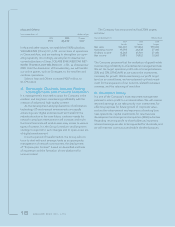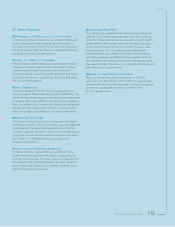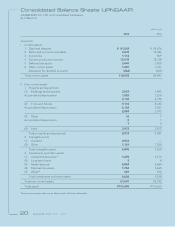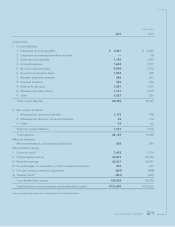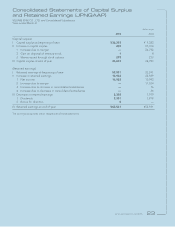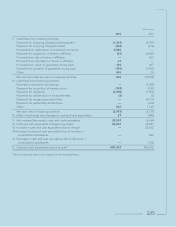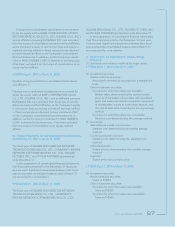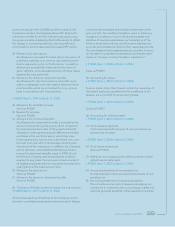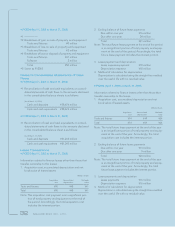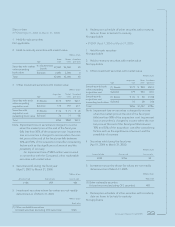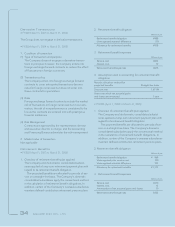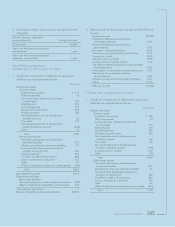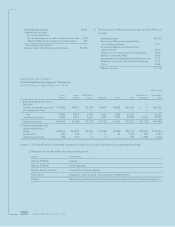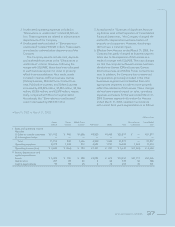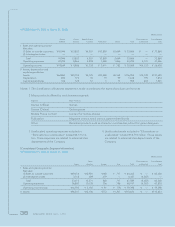Square Enix 2005 Annual Report Download - page 30
Download and view the complete annual report
Please find page 30 of the 2005 Square Enix annual report below. You can navigate through the pages in the report by either clicking on the pages listed below, or by using the keyword search tool below to find specific information within the annual report.
28 SQUARE ENIX CO., LTD.
B) Inventories
Manufactured goods, merchandise:
Same as FY 2003
Content production account:
Same as FY2003
Unfinished goods:
Same as FY2003
Supplies:
Same as FY2003
(2) Method for depreciation and amortization of major assets
• FY2003 (April 1, 2003 to March 31, 2004)
A) Property and equipment
Property and equipment of the Company and its domes-
tic consolidated subsidiaries are depreciated using the
declining-balance method.
Estimated useful lives of major assets are as follows:
Buildings and structures 3–50 years
Tools and fixtures 3–20 years
(Change in accounting policy)
Previously, assets with a purchase price greater than or
equal to ¥100,000 and less than ¥200,000 were depreciated
on a straight-line basis over a period of three years. To unify
the accounting policy as a result of the merger and to fur-
ther strengthen the financial position, from this fiscal year
acquired assets that are deemed to have an immaterial
impact on the Company’s consolidated financial position
are expensed at the time of purchase. The result of this
change on the Company’s consolidated operating income,
recurring income and income before taxes for the fiscal
year ended March 31, 2004 is considered immaterial.
B) Intangible assets
In-house software used by the Company and its domes-
tic consolidated subsidiaries is amortized using the
straight-line method based on an estimated useful life
of five years. For all other intangible fixed assets, trade-
marks are amortized using the straight-line method
based on an estimated useful life of 10 years. Goodwill
is amortized using the straight-line method over a
period of five years.
• FY2004 (April 1, 2004 to March 31, 2005)
A) Property and equipment
Property and equipment of the Company and its domes-
tic consolidated subsidiaries are depreciated using the
declining-balance method.
Estimated useful lives of major assets are as follows:
Buildings and structures 3–50 years
Tools and fixtures 3–15 years
B) Intangible assets
Same as FY2003
(3) Accounting for allowances and reserves
• FY2003 (April 1, 2003 to March 31, 2004)
A) Allowance for doubtful accounts
An allowance for doubtful accounts provides for possi-
ble losses arising from default on accounts receivable.
The allowance is made up of two components: the esti-
mated credit loss for doubtful receivables based on an
individual assessment of each account, and a general
reserve calculated based on historical default rates.
B) Reserve for bonuses
A reserve for bonuses provided for payments to employ-
ees of the Company and its consolidated subsidiaries
at the amount expected to be paid in respect of the
calculation period ended on the balance sheet date.
C) Allowance for retirement benefits
An allowance for retirement benefits is provided at the
amount incurred during this fiscal year, which is based
on the estimated present value of the projected benefit
obligation. Unrecognized actuarial differences are fully
amortized in the next year in which they arise. In addition,
the Company and its domestic consolidated subsidiaries
provide a reserve for retirement benefits equal to 100%
of such benefits the Company and its subsidiaries would
be required to pay under the lump-sum retirement plan
if all eligible employees were to voluntarily terminate
their employment at the balance sheet date.
(Additional Information)
Until the previous fiscal year, the Company had provided a
reserve for retirement benefits equal to 100% of such bene-
fits the Company would be required to pay if all eligible
employees were to voluntarily terminate their employment
at the balance sheet date. Effective from the current fiscal
year, as the number of Company employees exceeded 300
due to the merger with SQUARE, the Company changed its
accounting policy for reserve for retirement benefits to the
method described above.
As a result of this change, retirement expense increased
¥437 million, and recurring profit and income before
income taxes each decreased ¥416 million.
Moreover, this change in accounting method was
adopted in the second half of the fiscal year under review


